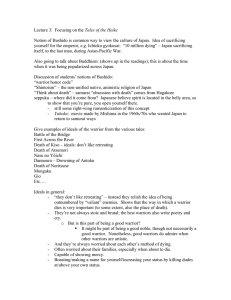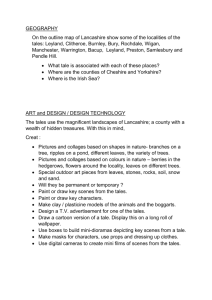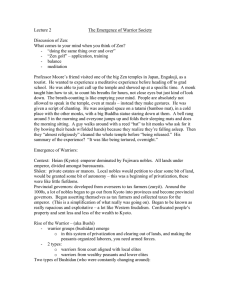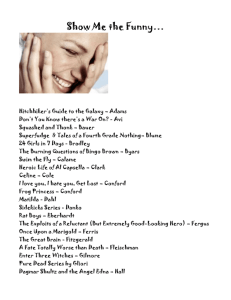21H.522 Handout Tales of Heike Some terms:
advertisement
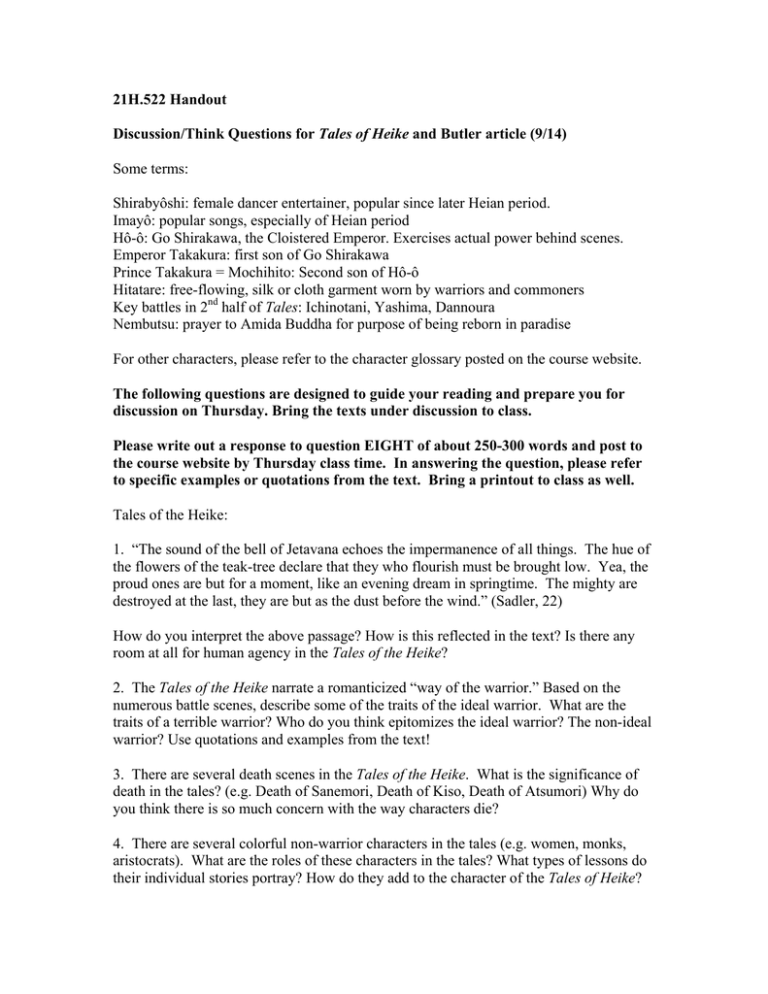
21H.522 Handout Discussion/Think Questions for Tales of Heike and Butler article (9/14) Some terms: Shirabyôshi: female dancer entertainer, popular since later Heian period. Imayô: popular songs, especially of Heian period Hô-ô: Go Shirakawa, the Cloistered Emperor. Exercises actual power behind scenes. Emperor Takakura: first son of Go Shirakawa Prince Takakura = Mochihito: Second son of Hô-ô Hitatare: free-flowing, silk or cloth garment worn by warriors and commoners Key battles in 2nd half of Tales: Ichinotani, Yashima, Dannoura Nembutsu: prayer to Amida Buddha for purpose of being reborn in paradise For other characters, please refer to the character glossary posted on the course website. The following questions are designed to guide your reading and prepare you for discussion on Thursday. Bring the texts under discussion to class. Please write out a response to question EIGHT of about 250-300 words and post to the course website by Thursday class time. In answering the question, please refer to specific examples or quotations from the text. Bring a printout to class as well. Tales of the Heike: 1. “The sound of the bell of Jetavana echoes the impermanence of all things. The hue of the flowers of the teak-tree declare that they who flourish must be brought low. Yea, the proud ones are but for a moment, like an evening dream in springtime. The mighty are destroyed at the last, they are but as the dust before the wind.” (Sadler, 22) How do you interpret the above passage? How is this reflected in the text? Is there any room at all for human agency in the Tales of the Heike? 2. The Tales of the Heike narrate a romanticized “way of the warrior.” Based on the numerous battle scenes, describe some of the traits of the ideal warrior. What are the traits of a terrible warrior? Who do you think epitomizes the ideal warrior? The non-ideal warrior? Use quotations and examples from the text! 3. There are several death scenes in the Tales of the Heike. What is the significance of death in the tales? (e.g. Death of Sanemori, Death of Kiso, Death of Atsumori) Why do you think there is so much concern with the way characters die? 4. There are several colorful non-warrior characters in the tales (e.g. women, monks, aristocrats). What are the roles of these characters in the tales? What types of lessons do their individual stories portray? How do they add to the character of the Tales of Heike? 5. Compare the warriors of the Heike and the Genji. Are there certain “unwarriorly” traits of the Heike that contribute to their downfall? If so, what are they? 6. What is the relation between Buddhism and warrior values in the Tales? 7. After reading the Tales, what overall mood do you detect? Is it one of victory or tragedy? 8. Compare some of the stories/images in the Tales of the Heike and/or “Hoichi the Earless” with contemporary representations of militaristic values or religious morals/the supernatural. What similarities and differences do you see? What purposes do you think they serve in each of their respective eras? Study/Think Questions for Butler Article: 9. What were some of the stylistic elements that biwa hôshi used to manufacture the warrior ethic? 10. Summarize Butler’s argument. What is the irony of it? 11. Compare the techniques that biwa hôshi created a sense of historical validity and authenticity with the way that historians establish historical validity (e.g. in history textbooks or academic articles). Aside from the obvious differences, can you see any similarities? If so what are they?
